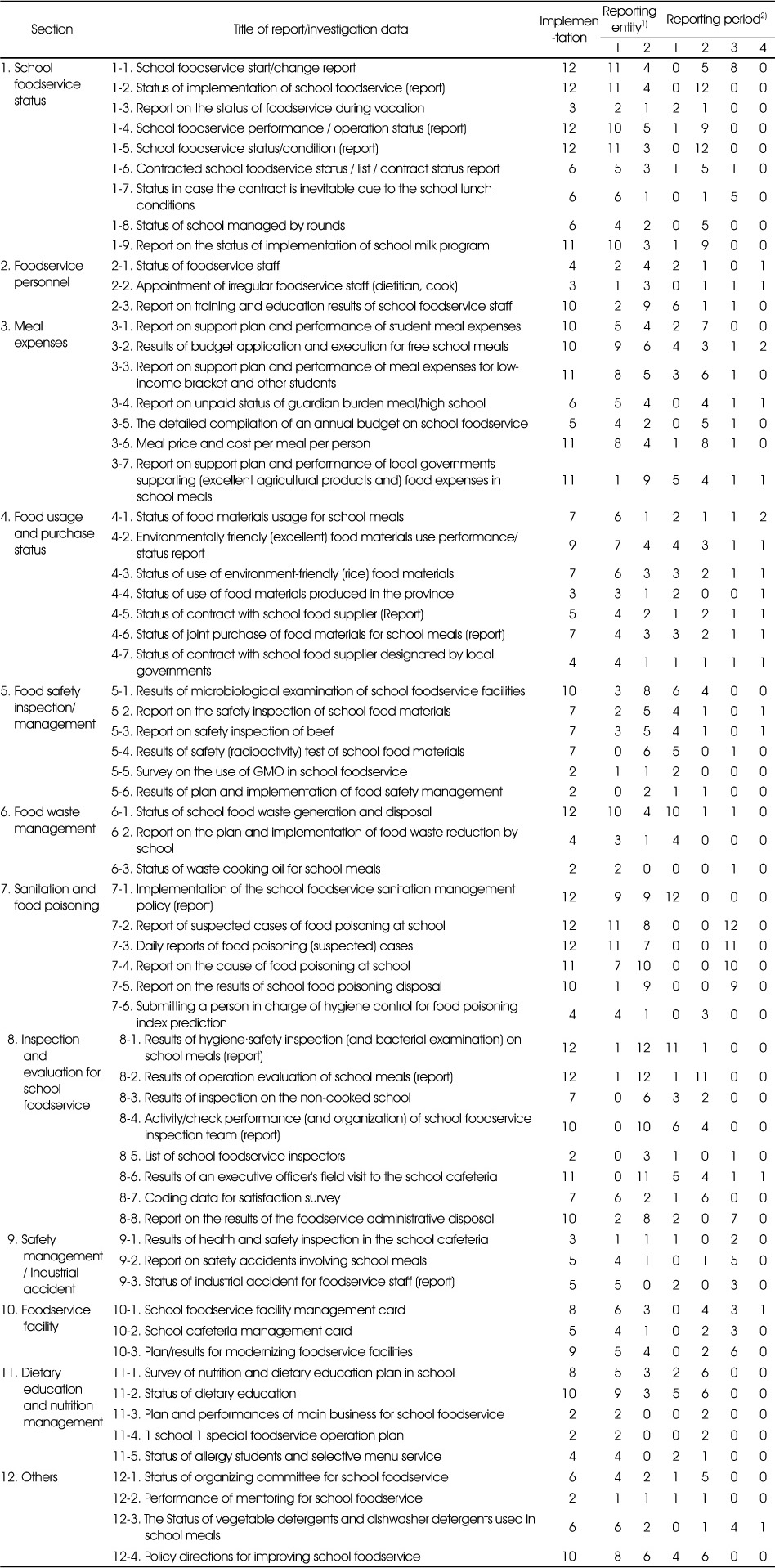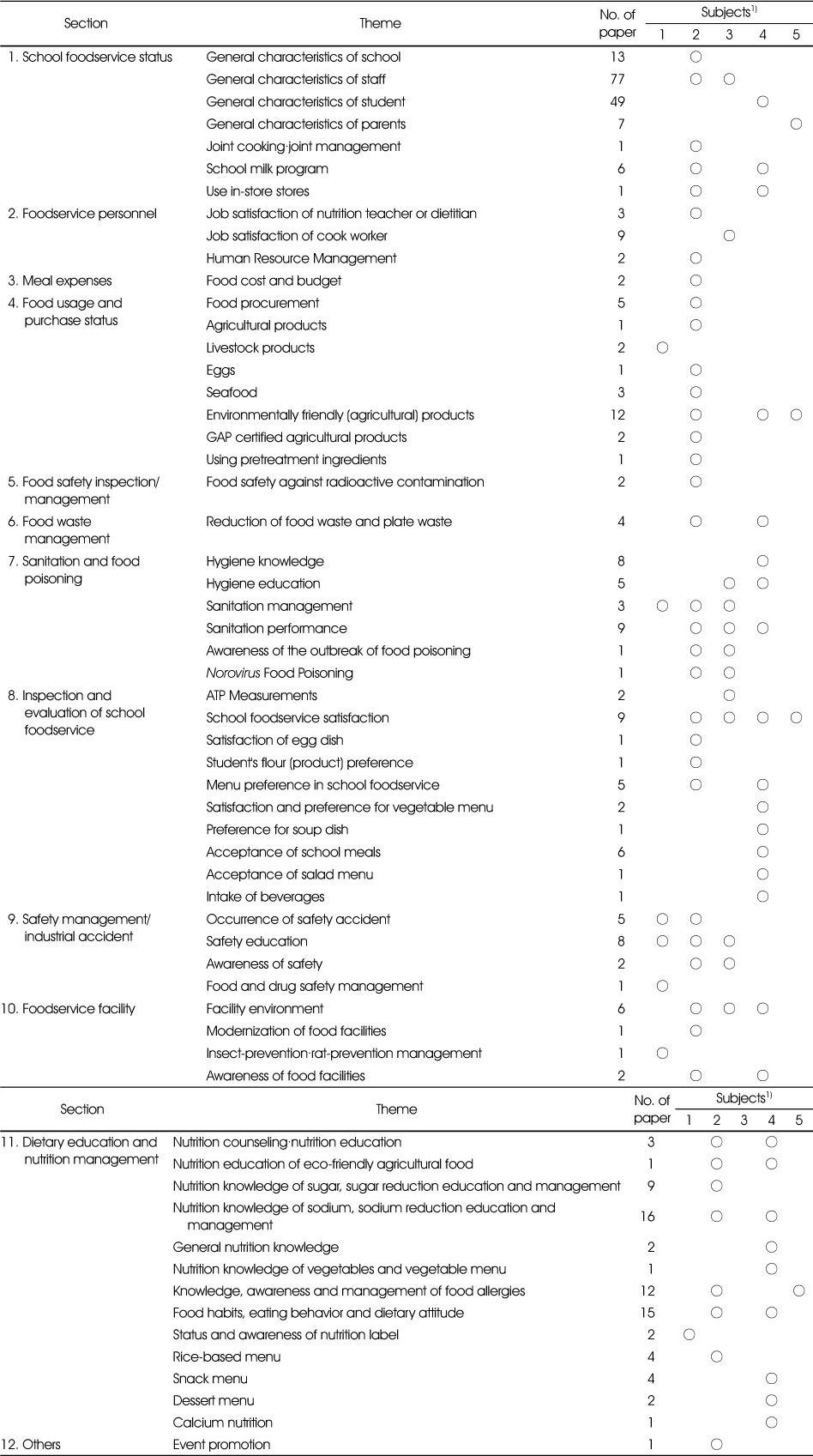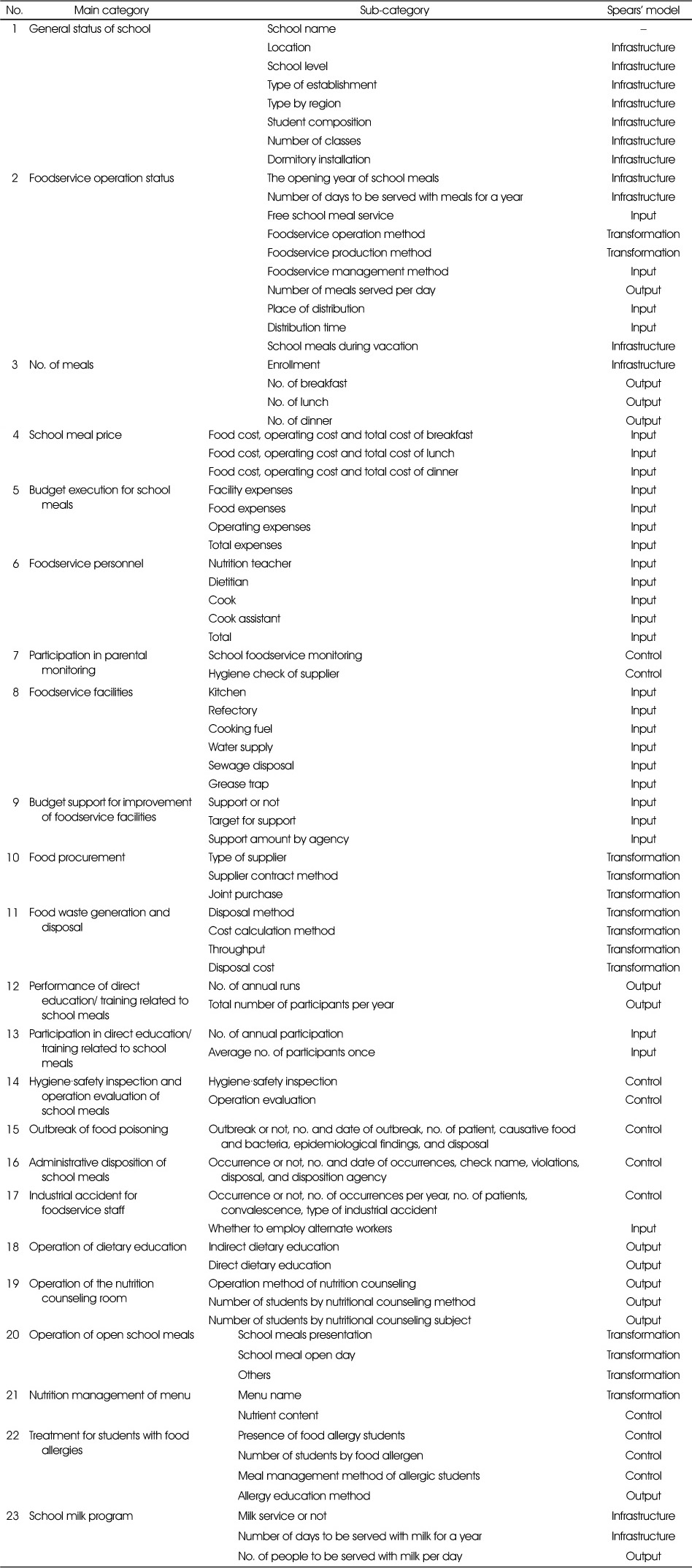Articles
- Page Path
- HOME > Korean J Community Nutr > Volume 24(1); 2019 > Article
-
Research Article
- Development of Model for 「The Survey on School Foodservice Programã€
-
Hae-Young Lee, Bo-Sook Yi, Jina Cha, Sun-Ok Ham, Moon-Kyung Park, Mi-Nam Lee, Hye-Young Kim, Haeng-Hwa Kang, Jin-Wook Kwon, Yun-Hui Jeong

-
Korean Journal of Community Nutrition 2019;24(1):60-76.
DOI: https://doi.org/10.5720/kjcn.2019.24.1.60
Published online: February 28, 2019
1Department of Food & Nutrition, Sangji University, Wonju, Korea, Professor.
2Department of Food & Nutrition, Hanyang Women's University, Seoul, Korea, Professor.
3Department of Korean Cuisine, Jeonju University, Jeonju, Korea, Professor,
4Department of Food & Nutrition, Yonsei University, Seoul, Korea, Professor.
5Department of Food & Nutrition, Hanyang Women's University, Seoul, Korea, Associate professor.
6Department of Food & Nutrition, Yeonsung University, Anyang, Korea, Assistant professor.
7Graduate School of Human Environmental Sciences, Yonsei University, Seoul, Korea, Adjunct professor.
8Student Health Policy Division, Ministry of Education, Sejong, Korea, Deputy director.
9Health Promotion Center, Korea Educational Environments Protection Agency, Osong, Korea, Director.
10Institute of Social Welfare, Sungkonghoe University, Seoul, Korea, Research professor.
- Corresponding author: Yun-Hui Jeong. Institute of Social Welfare, Sungkonghoe University, 320 Yeondong-ro, Guro-gu, Seoul 08359, Korea. Tel: (02) 2610-4749, Fax: (02) 2610-4140, yhjeong11@naver.com
Copyright © 2019 The Korean Society of Community Nutrition
This is an Open-Access article distributed under the terms of the Creative Commons Attribution Non-Commercial License (http://creativecommons.org/licenses/by-nc/3.0/) which permits unrestricted non-commercial use, distribution, and reproduction in any medium, provided the original work is properly cited.
- 1,206 Views
- 5 Download
- 1 Crossref
Abstract
-
Objectives
- The purpose of this study was to develop a systematic and standardized「The Survey on School Foodservice Program」that can identify the current status of school meals on the nationwide level.
-
Methods
- This study was carried out in six steps of the analysis of report/investigation data related to school foodservice in metropolitan and provincial offices of education, analysis of preceding research related to the actual status of school foodservice, field verification of the actual condition of the school foodservice site, development of a draft of「The Survey on School Foodservice Program」, pilot study of a draft of 「The Survey on School Foodservice Program」, and suggestions of a final model of「The Survey on School Foodservice Program」from August to December, 2017. Statistical analysis was performed for frequency analysis and descriptive analysis using the SPSS program ver. 23.
-
Results
- A draft of「The Survey on School Foodservice Program」was developed by analyzing the current status of report/research data on school meals in metropolitan and provincial offices of education, analyzing the preceding research on school meals, and identifying the actual conditions at school foodservice sites. To verify the validity of the school foodservice survey questionnaire, 1,031 schools were sampled from a total of 10,251 schools and the pilot test of ‘2017 School Foodservice Survey’ was conducted. The final model of「The Survey on School Foodservice Program」consisted of 12 survey sections, 29 survey categories, and 433 survey items, and the survey cycle was set for one year and three years for each survey item.
-
Conclusions
- Based on the objective statistical data through「The Survey on School Foodservice Program」, it is possible to develop the school foodservice policy, which will help establish the reliability of the school meals.
Acknowledgments
Acknowledgments
- 1. National Law Information Center. School Meals Act. Act No. 11771 [Internet]. Ministry of Government Legislation; 2013; updated 2013 May 22]. cited 2019 Jan 10]. Available from: http://www.law.go.kr/lsSc.do?tabMenuId=tab18&query=%ED%95%99%EA%B5%90%EA%B8%89%EC%8B%9D%EB%B2%95#undefined.
- 2. Yang IS, Yi BS, Cha JA, Lee JM, Han KS, Chae IS, et al. Foodservice in institutions. 4th ed. Paju: Kyomunsa; 2018. p. 18.
- 3. Ministry of Education. Current status of school foodservice in 2017. Sejong: Ministry of Education; 2018.
- 4. National Law Information Center. School Meals Act. Act No. 7962 [Internet]. Ministry of Government Legislation; 2007; updated 2006 Jul 19]. cited 2019 Jan 10]. Available from: http://www.law.go.kr/lsInfoP.do?lsiSeq=74880&ancYd=20060719&ancNo=07962&efYd=20070120&nwJoYnInfo=N&efGubun=Y&chrClsCd=010202#0000.
- 5. National Law Information Center. Enforcement Rule of the School Meals Act. Rule No. 96 [Internet]. Ministry of Government Legislation; 2016; updated 2016 Apr 20]. cited 2019 Jan 10]. Available from: http://www.law.go.kr/lsSc.do?tabMenuId=tab18&query=%ED%95%99%EA%B5%90%EA%B8%89%EC%8B%9D%EB%B2%95#undefined.
- 6. Ministry of Education. School foodservice sanitation management guideline. 4th ed. Sejong: Ministry of Education; 2016.
- 7. Korean Educational Development Institute. Survey on school foodservice satisfaction in 2017. Jincheon: Korean Educational Development Institute; 2018.
- 8. Yang IS, Kim HA, Shin SY, Jo MN, Park SY, Cha JA. The analysis of operational characteristics in contract-managed high school foodservice in Seoul. J Korean Diet Assoc 2002; 8(3): 280-288.
- 9. Park SJ, Youn DK, Lee YE. Operation status and dietitian's perceptions regarding commissary school foodservices in Chungcheong. J Korean Soc Food Sci Nutr 2018; 47(9): 934-946.Article
- 10. Yang IS, Park MK. Identifying the quality attributes affecting customer satisfaction of school foodservice by city and province: students, parents, and faculty. J Korean Diet Assoc 2008; 14(3): 302-318.
- 11. Yi BS, Yang IS, Park MK. Annual analysis on quality attributes and customer satisfaction in school foodservice. Korean J Nutr 2009; 42(8): 770-783.Article
- 12. Kim KJ, Yi BS, Park MK. Analysis of the recognition and quality attributes on school lunch service of middle school students by gender in Gyeonggi province. J Korean Soc Sch Health 2010; 23(2): 295-307.
- 13. Park MK, Yang IS, Yi BS, Kim YS. Analysis of quality attributes and the customer satisfaction in school foodservice by school type and distribution place. J Korean Diet Assoc 2010; 16(2): 83-99.
- 14. Yang IS, Yi BS, Park MK, Baek SH, Chung YS, Jeong JY. Evaluation of the quality attribute and satisfaction on school foodservice in 2010. Korean J Community Nutr 2013; 18(5): 491-504.Article
- 15. Ahn YJ, Lee YE, Park EH. Current and future operation on menu management of school foodservices in Chungbuk: milk program and food material management. J Human Ecol 2014; 18(1): 67-83.
- 16. Jung SH, Lee YE, Park EH. Use and perception of environmentally-friendly ingredients by dietitians in Chungbuk. J Korean Soc Food Sci Nutr 2015; 44(10): 1567-1582.Article
- 17. Kwak SJ, KiM SJ, Lkhagvasarnai E, Yoon KS. Analysis of microbiological hazards of preprocessed namuls in school food service and processing plant. J Food Hyg Saf 2012; 27(2): 117-126.Article
- 18. Yang JH, Sung BM, Kim MH, Jung HS, Cha MH, Ryu K. Dieticians' perceived performance level and obstructive factors of HACCP system among elementary school food services in Gyeongbuk province. J Korean Soc Food Sci Nutr 2014; 43(11): 1774-1784.Article
- 19. Min JH, Park MK, Kim HJ, Lee JK. Systemic analysis on hygiene of food catering in Korea (2005-2014). J Food Hyg Saf 2015; 30(1): 13-27.Article
- 20. Kye SH, Hwang SH. Evaluation of management and hygienic status of high school foodservice using ATP bioluminescence assay. Korean J Food Nutr 2017; 30(3): 515-524.
- 21. Lee YE, Yang IS, Cha JA. The importance and categorization of task elements of school food service dietician. J Nutr Health 2002; 35(6): 668-680.
- 22. Lee JT, Shin BK, Kim HC. The impacts of job insecurity, job stress and organizational commitment on turnover intention of commercial and institutional foodservice employees. J Tour Sci 2011; 35(8): 209-228.
- 23. Heu HN, Choi HS, Lee HY. Relationship between students' foodservice satisfaction and foodservice employees' job satisfaction at elementary schools. J Korean Diet Assoc 2012; 18(2): 155-169.Article
- 24. Heu HN, Lee HY. The effect of employee service mind on customer orientation in elementary school foodservice. J Korean Diet Assoc 2013; 19(1): 82-94.Article
- 25. Lee HY. The effect of workplace mobbing on self-esteem of school foodservice employees with different level of coworker support. Korean Manag Consult Rev 2015; 15(2): 173-182.
- 26. Kim JH, Cha JA. Development of job description of nutrition teacher by the DACUM method. J Korean Diet Assoc 2016; 22(3): 193-213.Article
- 27. Lee HJ, Kim YS, Kim SY, Cha JA, Ham S. Comparison of required and additional man power's implemental task elements between present and future-oriented duties of school nutrition teachers. J Korean Diet Assoc 2017; 23(2): 155-179.
- 28. An YS, Choi HS, Lee HY. Comparison of wage treatment, employment environment, and job stability before and after conversion to indefinite contract status for school foodservice employees in Gangwon province. J Korean Diet Assoc 2018; 24(3): 261-274.
- 29. Cho HA, Lee YE, Park EH. Actual conditions and perception of safety accidents by school foodservice employees in Chungbuk. J Korean Soc Food Sci Nutr 2014; 43(10): 1594-1606.Article
- 30. Kim JM. A study on improvements of food service facility in middle and high school based on satisfaction survey: Focused on Seoul, Gyeonggi province, and Incheon. J Korean Inst Youth Fac Environ 2016; 14(1): 33-42.
- 31. Hur BY, Choi IJ, Kim MY, Kwon JW, Lee JY, Yoon JH. Current status of parents' monitoring and level of trust in school lunch programs. Korean J Community Nutr 2017; 22(5): 401-412.ArticlePDF
- 32. Lee EJ, Lee HY. Experience and vision of nutrition education by nutrition teacher candidate in school. Korean J Food Culture 2009; 24(4): 440-450.
- 33. Kim HJ, Kim HA. Perception of nutritional education among school administrators, patients, and school nutrition teachers at an elementary school. J Korean Diet Assoc 2012; 18(4): 385-399.
- 34. Jung KA. The review of the researches on the nutritional education state in the elementary school. J Korean Pract Arts Educ 2013; 19(1): 117-145.Article
- 35. Korean Educational Development Institute. Basic survey on school foodservice operating condition. Jincheon: Korean Educational Development Institute; 2016.
- 36. Kwak TK, Chang HJ, Song JY. Development of performance indicators based on balanced score card for school food service facilities. Korean J Community Nutr 2005; 10(6): 905-919.
- 37. Lee AH. Food allergy management practice and perceptions of students and parents on the implementation of food allergen labeling in school foodservice [master's thesis]. Yonsei University; 2014.
- 38. Kim NY. Development of evaluation tools of quality control of food ingredients in school feeding [doctoral dissertation]. Kyonggi University; 2014.
- 39. Park SH, Choe YC. Students' satisfaction of school lunch according to the dietary habit and educational experience of nutrition and food. Fam Environ Res 2015; 53(4): 425-432.Article
- 40. Kim HH, Park YH, Shin EK, Shin KH, Bae IS, Lee YK. Students' and parents' perceptions of nutrition education in elementary schools. J Korean Soc Food Sci Nutr 2006; 35(8): 1016-1024.Article
- 41. Schwartz MB, Just DR, Chriqui JF, Ammerman AS. Appetite self-regulation: Environmental and policy influences on eating behaviors. Obesity 2017; 25: S26-S38.ArticlePubMedPDF
- 42. Taber DR, Chriqui JF, Chaloupka FJ. State laws governing school meals and disparities in fruit/vegetable intake. Am J Prev Med 2013; 44(4): 365-372.ArticlePubMedPMC
REFERENCES
Figure & Data
REFERENCES
Citations

- Developing educational videos to inform rightly about school foodservice from kindergarten to high school: a case study
Gyoungok Gang, Chaewon Park, Haejin Kang, Wan Soo Hong, Yoo Kyoung Park, Sook Hee Choi, Seung Hye Kim, Jieun Choi, Jihyun Park, Hyeja Chang
Korean Journal of Community Nutrition.2024; 29(2): 97. CrossRef


Fig. 1
Fig. 2
Report/investigation data related to school foodservice in metropolitan · provincial office of education N=12
1) 1=School, 2=District office of education
2) 1=Twice a year, 2=Once a year, 3=When it happens, 4=Etc.
Analysis of preceding research related with the actual status of school foodservice during the past five years (2013 ~ 2017)
1) 1=School, 2=Nutrition teacher or dietitian, 3=Cook worker, 4=Student, 5=Parents
A design draft of「The Survey on School Foodservice Program」
Composition of a final model of「The Survey on School Foodservice Program」
1) 1=School, 2=District office of education 2) 1=Twice a year, 2=Once a year, 3=When it happens, 4=Etc.
1) 1=School, 2=Nutrition teacher or dietitian, 3=Cook worker, 4=Student, 5=Parents

 KSCN
KSCN






 Cite
Cite


